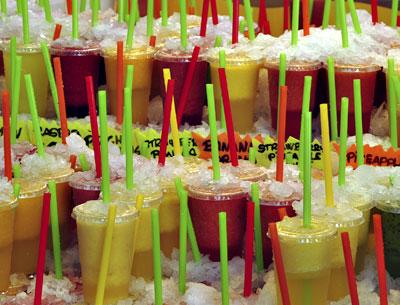Seasons by the Sea: Smoother Not Always Better

My son’s friend Omar came to visit the other day and presented me with a plastic cup of green stuff. “I got this smoothie at _____. It cost $20!” The green stuff was starting to turn grayish and separate in the cup. I politely took a sip and wished the nice young man had saved his $20. It tasted awful.
Juices and smoothies have become so popular, it seems that as soon as people exit their spinning or yoga classes they have purple or green beverages attached to their hands, expensive purple or green beverages! Are they worth it?
Having worked in a restaurant that had a smoothie menu, I can tell you this, the fruit in your smoothie was most likely carelessly cut up three days ago. The protein powder addition is Brand X, and the wheatgrass should have been tossed in the trashcan a week ago. You are better off eating a single piece of fruit and a carton of yogurt . . . for a 10th of the price.
Some local places like Juicy Naam and Provisions in Sag Harbor do a booming business with smoothies. These establishments have such a high turnover you can be pretty sure the ingredients are as fresh and organic as can be. But what about those bigger commercial chains that have jumped on the smoothie bandwagon? You would be shocked to know the sugar and fat content of many of their smoothies. Planet Smoothie’s Java the Nut has 22 grams of fat in a 22-ounce portion. Smoothie King’s Strawberry Hulk has 1,035 calories and 32 grams of fat per 20-ounce serving. Dairy Queen takes the cake with the seemingly healthy sounding Tropical Blizzard, which contains 62 grams of fat!
Smoothies can be made with soy, almond, or any kind of milk you desire, yogurt, fresh or frozen fruit, various vegetables, and additions like protein powder, ground hemp, chia, and flax seed. You get into the danger zone when you add chocolate, peanut butter, or sweetened syrups. If you’re going to have a smoothie as a meal substitute, make or buy one that has at least five grams of protein and plenty of fiber, otherwise you’ll be hungry again very soon. For sweetness I like to use good maple syrup or local honey. For fiber I add oatmeal and I find that a nice chunk of ginger or citrus adds some zing, especially to vegetable-based smoothies or juices. “Superfood” powders are a matter of taste; I like Spirutein. Whey protein is easy to digest and contains all the essential amino acids. Coconut water is good because it is rich in potassium and electrolytes. Bananas add richness but also a good bit of sugar. Try a quarter or half an avocado instead. Although high in fat, avocados are full of potassium, B-complex vitamins, antioxidants, and fiber. They also contain oleic acid and linoleic acids that are helpful in reducing L.D.L. cholesterol and increasing healthy H.D.L. cholesterol.
Store-bought juices and smoothies cost on average between $5 and $20 with add-ins. Naturally, you’re better off making your own. It’s worth the investment to get a super strong blender like a Vitamix or a juicer from Breville. Food is just too fun and important to me to make smoothies a regular habit. I believe they should be the occasional supplement, not substitute for a meal.
For making homemade smoothies I like to keep a variety of fruit in the freezer. When berries are a reasonable price at the market I freeze them on trays, then transfer them to Ziploc baggies. I have lost all faith in those bagged baby carrots and baby spinach leaves. It really is worthwhile to get carrots that still have their frilly greenery on top and buy spinach by the bunch. Yes, you must wash and/or peel these vegetables but the vitamins and flavor will be astonishingly better. Experimenting with different yogurts is fun; try sheep or goat’s milk if cow doesn’t agree with you. Avoid the fruity sweetened ones, you’ll just be ingesting more sugar you don’t need. Use high quality cocoa powder instead of chocolate syrup, and try various herbs and spices like mint leaves, cinnamon, and cardamom. If you add raw almonds, other nuts, or goji berries to smoothies, soak them overnight in the refrigerator, this will make them easier to blend and digest.
While I would like to believe that most of us are eating balanced meals every day, full of proteins and fiber and vitamins and complex carbohydrates, sometimes it’s just not possible. Smoothies are a fun and refreshing way to get some of our vital nutrients, just be aware of what they’re made of, and of what they can do to your wallet.
Click for recipes
